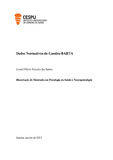| dc.contributor.advisor | PEIXOTO, BRUNO MIGUEL RAPOSO TÁVORA DE BARROS | |
| dc.contributor.author | Santos, Leonel Flávio Teixeira dos | |
| dc.date.accessioned | 2022-08-01T09:02:09Z | |
| dc.date.available | 2022-08-01T09:02:09Z | |
| dc.date.issued | 2022 | |
| dc.identifier.uri | http://hdl.handle.net/20.500.11816/3912 | |
| dc.description.abstract | Introdução: O reconhecimento emocional de faces demonstra um papel de grande relevância, uma vez que é uma competência social básica do ser humano, que permite ao sujeito responder de forma empática e compreender de que forma as suas ações afetam os outros.
Objetivo: Este estudo tem como objetivo a obtenção de dados normativos do Gandra-BARTA, que contém 59 fotografias com as 6 emoções básicas (alegria, tristeza, nojo, raiva, medo e surpresa) e neutras. Posteriormente, pretende-se perceber de que forma o desempenho na prova é influenciado por variáveis sociodemográficas, neurocognitivas e emocionais, numa amostra de indivíduos cognitivamente incólumes.
Métodos: A amostra conta com 166 participantes, de ambos os sexos, com idades compreendidas entre os 18 e os 82 anos de idade, sem queixas subjetivas de memória e completamente independentes nas atividades de vida diária. Os participantes foram submetidos a uma avaliação neuropsicológica, que incluiu: Gandra-BARTA; Montreal Cognitive Assessment (MoCA); Beck Depression Inventory-II (BDI-II).
Resultados: A idade relacionou-se negativamente com a identificação das emoções nojo, medo, raiva e surpresa e expressões neutras, contudo, correlacionou-se positivamente com a alegria. A escolaridade e o MoCA apresentam uma correlação positiva com a identificação das emoções nojo, raiva e expressões neutras. Os resultados obtidos no MoCA explicam em 37,4% a variância do número de acertos totais, 29,3% das identificações da expressão nojo e 51,6% a identificação das expressões faciais neutras. O sexo explica em 20,3% a identificação da emoção tristeza, bem como, 17,3% da identificação da emoção alegria. A idade explica 28,3% da identificação da emoção raiva e 8,9% da identificação da emoção surpresa. A identificação do medo é explicada em 11,6% pela escolaridade. Os resultados no BDI-II, não se correlacionaram significativamente com nenhum dos domínios do Gandra-BARTA.
Conclusão: A disponibilização das equações normativas, com as correções para a idade, anos de escolaridade, sexo e resultado no MoCA, permite o uso do Gandra-BARTA em contexto clínico. | pt_PT |
| dc.description.abstract | Introduction: The emotional recognition of faces demonstrates a role of great importance since it is a basic social competence of human beings, which allows the subject to respond empathically and understand how their actions affect others.
Objective: This study aims to obtain normative data from the Gandra-BARTA, which contains 59 photographs with the 6 basic emotions (happiness sadness, disgust, anger, fear, and surprise) and neutral. Subsequently, it is intended to understand how performance on the test is influenced by sociodemographic, neurocognitive, and emotional variables, in a sample of cognitively unharmed individuals.
Methods: The sample has 166 participants of both sexes, aged between 18 and 82 years old, without subjective memory complaints and completely independent in activities of daily living. Participants underwent a neuropsychological assessment, that include: Gandra-BARTA; Montreal Cognitive Assessment (MoCA); Beck Depression Inventory II (BDI II).
Results: Age was negatively related to the identification of emotions disgust, fear, anger, surprise, and neutral expressions. However, age was positively correlated with happiness. Schooling and MoCA present a positive correlation with the identification of emotions disgust, anger, and neutral expressions. The results obtained in the MoCA explain in 37.4% the variance in the number of total hits, 29.3% of the identifications of disgust expression and 51.6% of the identification of neutral facial expressions. Gender explains in 20.3% the identification of the emotion of sadness, as well as 17.3% of the identification of the emotion of joy. Age explains 28.3% of the identification of the emotion of anger and 8.9% of the identification of the emotion of surprise. The identification of fear is explained in 11.6% by schooling. The results in the BDI-II did not significantly correlate with any of the Gandra-BARTA domains.
Conclusion: The availability of normative equations, with corrections for age, years of schooling, sex, and result in the MoCA, allows the use of Gandra-BARTA in a clinical context. | pt_PT |
| dc.language.iso | por | pt_PT |
| dc.rights | info:eu-repo/semantics/openAccess | pt_PT |
| dc.subject | Emoções | pt_PT |
| dc.subject | Reconhecimento emocional | pt_PT |
| dc.subject | Expressão emocional | pt_PT |
| dc.subject | Avaliação neuropsicológica | pt_PT |
| dc.subject | Faces | pt_PT |
| dc.title | Dados Normativos do Gandra-BARTA | pt_PT |
| dc.type | info:eu-repo/semantics/masterThesis | pt_PT |
| dc.identifier.tid | 203035860 | pt_PT |
| thesis.degree.name | Mestrado em Psicologia da Saúde e Neuropsicologia | pt_PT |


